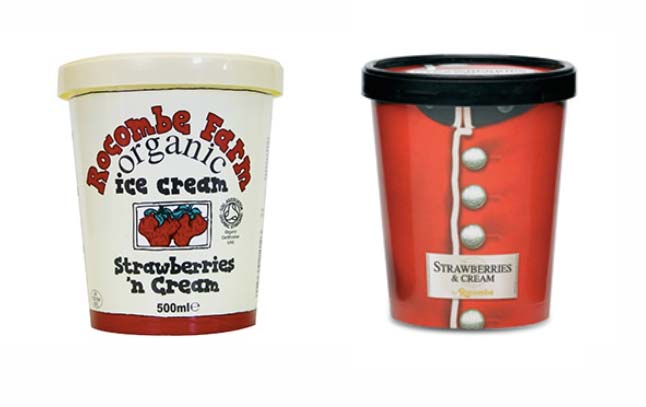![]() By Caroline Hagen
By Caroline Hagen
Think it might be time to reconsider your brand identity? It’s a big step – but one that can deliver huge rewards if your reasoning and research is right. Caroline Hagen recaps what to consider before updating or renewing your brand identity.
What’s in a brand?
The brand is the touchy-feely side of your product or service. It’s the part that creates the emotional connection with your consumer. The look of it is how your consumer recognises you and builds trust in your brand. As long as your brand identity stays the same, your consumer will assume that you continue to deliver the same quality standards, in the same way that they’ve come to expect.

What happens when you make a change?
If you choose to make a dramatic change to the look of your brand identity or packaging, you’ll potentially change consumers’ perceptions of your brand as a whole. You signal that something about your product or service has changed – it can be a great opportunity to make a more meaningful connection.

So is it a good idea to change branding?
Absolutely. There are four situations where updating or renewing your brand identity can deliver real rewards:
Updating or refreshing:
1. Your current brand identity is out of date with the marketplace
2. It no longer represents your product or service
3. It doesn’t appeal to your core target audience
Creating a new brand
4. You have a new product or service to launch that won’t work with your current branding
Reasons to update, renew or refresh
The unappealing brand
Your current identity might not be attracting the right sort of consumer. For example, your product might be very ethically sound, but your brand identity or name doesn’t appeal to a thoughtful millennial who would appreciate these values. This is also true of a brand that’s aged over time and become out of date within a marketplace.
The mismatched brand
Your product quality might not match the promise of your brand and packaging. So, perhaps your product is top quality, but your look isn’t premium. In this case, a change in branding will be great for you. A new, more premium look will appeal to new prospects, and reassure your loyal consumer – they were clever to be loyal to you in the first place and were ‘in on the secret’.

When is it time to start from scratch?
If you’re updating, the new identity you create should be a natural reflection of the brand you truly are. It should feel intuitive to your loyal consumer – a natural update of something that has become out of date. If you’ve changed your spots altogether, though, it’s likely that you’ll be better off creating a new brand entirely.
7 practical tips for rebrand success
Now you’ve decided to update your brand, how do you get the best out of the rebranding process? It’s all about doing your research. Though branding is a science – and it’s best to get a good agency to lead you through the process – here are 7 steps to consider when you begin a rebrand project.
- Find your point of difference
Start by identifying what makes your brand really different or unique. You may be one of the few whose offer is genuinely unique, but it’s quite unlikely that you’ve come up with the only “whatever-you-sell” ever. So use your brand to create an important difference in your consumer’s eyes – give them a reason to choose your product over your competitor’s.
- Get to know your dream customer
Consider your consumer, and paint a picture of them. The more detailed and precise this is, the more you know about their habits and attitudes, the closer you can tailor your brand and product truths to create a brand identity that appeals to them.
- Perfect your proposition
Think about how you can make your proposition and values really tightly focussed on your target. The more uncomfortable this feels, the better. As you start thinking “well so and so type of consumer might not like this”, the greater appeal your core values will have for your bullseye consumer. I’m not suggesting you make anything up – social media will soon find you out – just dig deep to find out the particular gap in the market your brand is best placed to fill.
- What’s in a name?
Should you change your brand name as part of the update? Sometimes a change can signal change. For example, New Covent Garden Soup became New Covent Garden Food Company as a precursor to the introduction of non-soup lines. Meanwhile, the move to an abbreviation can help signal modernisation.
- Finding your look and feel
The look and feel of your brand identity will help consumers see you in a particular way. You’ve probably already got some idea of the sort of brand identities you already like in your own or similar marketplaces. Start putting together some pictures of the look and feel you think would be most appropriate for your brand.
- Bad news is good news
Also consider what you think works – and what doesn’t work. Include feedback you may have received in the past from customers or consumers. And if you are embarking upon an update of your brand identity, consider what should be retained because it has become a visual equity of your brand.
- Choosing your agency
Having done all that, you’re now in a position to decide which branding agency you’d like to partner with to translate all this into a visually compelling new brand identity. Well, you need look no further… contact Reach.
Glossary
Brand
The essence of your company and your product. The ‘what makes you different’. Coca-Cola vs. Pepsi. The relationship between a business and an audience.
Brand identity
The visual expression of a brand. Everything you create to shape the consumer’s perception of your brand – logo, design and words, ads, packaging, website etc.
Branding
The craft of creating a brand – and also, the discipline of helping businesses express themselves as brands.
